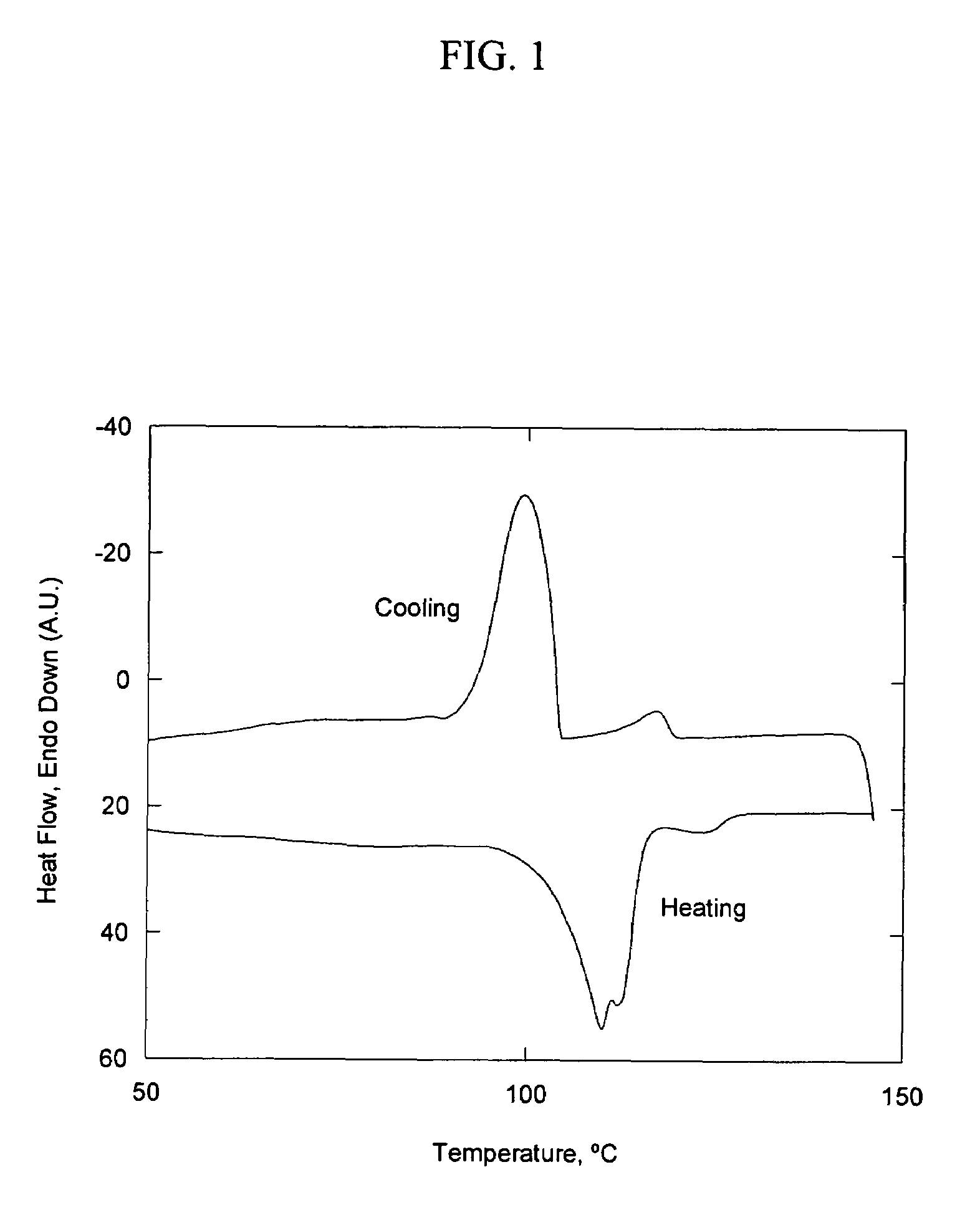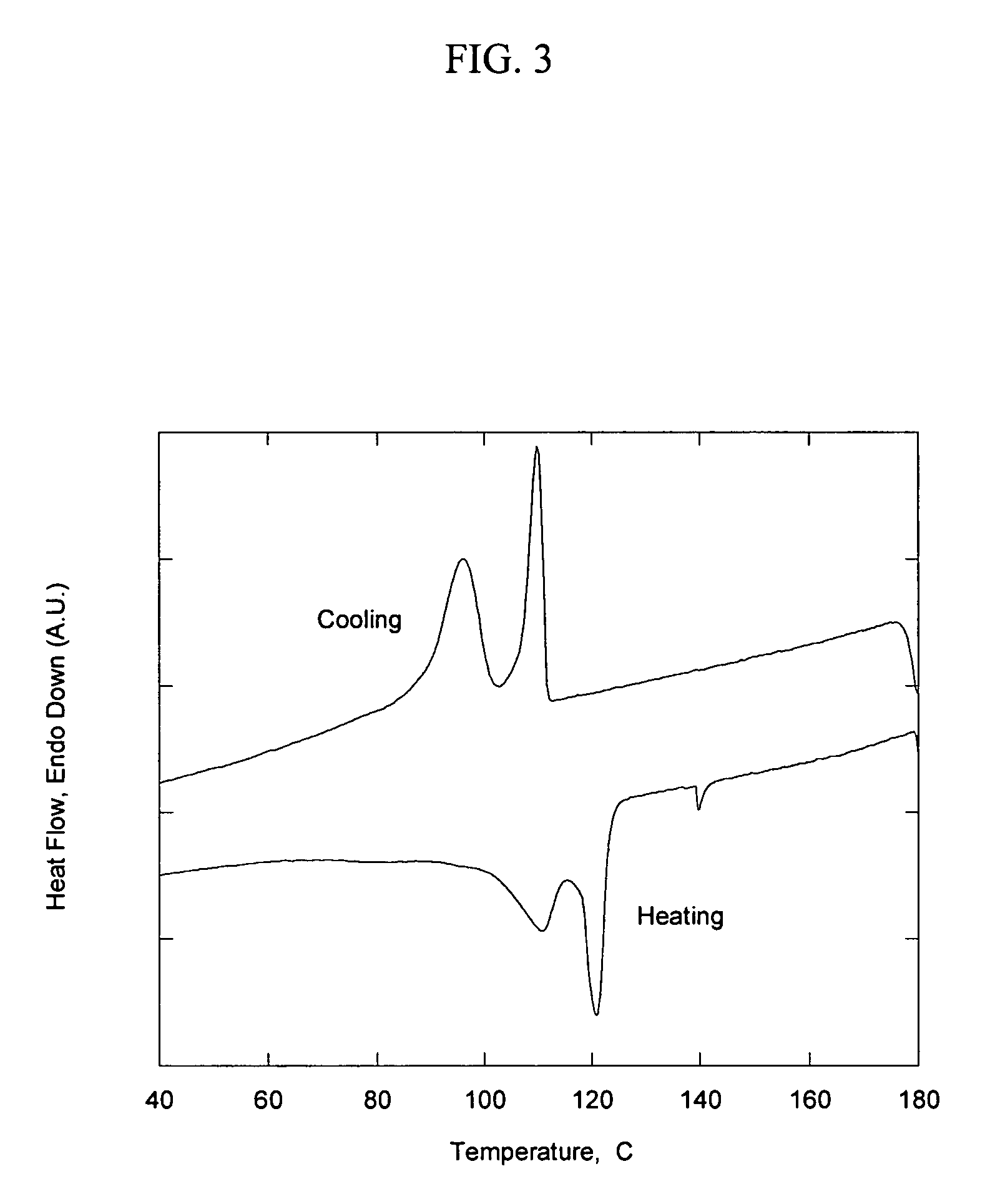Thermally stable surfactants and compositions and methods of use thereof
a surfactant and thermal stability technology, applied in the field can solve the problems of nanocomposite formation providing only modest improvements in the mechanical properties of polyolefins, composite and nanocomposite performance not always living up to expectations, and missing theoretical barrier properties, etc., to achieve superior dispersion stability, improve the barrier properties of polymer composites and nanocomposites, and increase the dispersion of fillers
- Summary
- Abstract
- Description
- Claims
- Application Information
AI Technical Summary
Benefits of technology
Problems solved by technology
Method used
Image
Examples
example 1
Formation of a High-Melting Surfactant Using Polyethylene Monoalchohol, Isocyano and Catalyst
[0080]This example illustrates the preparation of a high-melting surfactant suitable for dispersing additives such as fibers, mineral fillers, dyes, and pigments in polyethylene and ethylene propylene random copolymer. A high molecular weight telometric surfactant was prepared by melting 150 g of polyethylene monoalcohol (Aldrich, Mn 460, OH number=105 mg KOH / g) in a three-neck, round-bottom glass reactor at 170° C., under nitrogen purge. The reactor was also equipped with a magnetic stirrer. Once the alcohol was melted, a stoichiometric amount of 1,6-diisocyanatohexane and 0.086 g dibutyltin dilaurate (a catalyst) were added to the reactor with stirring. The melt was stirred for several hours, removed from the reactor and cooled to yield a crystalline product. Surprisingly, the melting point of the product was considerably higher than that of the starting alcohol. The starting monoalcohol h...
example 2
Preparation of a Quaternary Amine
[0084]A common approach to making clay / polymer nanocomposites in the past has been to treat a smectite clay to make the surface compatible with thermoplastic and thermoset polymers by exchanging the basal surface of the clay with a high-molecular-weight quaternary amine. A commonly used amine is dimethyl dihydrogenated tallow ammonium chloride. The presence of the dimethyl group allows the molecule to adopt an upright position at high surface loadings which in turn allows the two long alkyl chains to shield the polar ammonium cation from the external surface of the surfactant monolayer coating. The presence of two tallow chains in the molecule introduces enough disorder in the monolayer to produce an alkyl chain melting point of approximately 40-50° C. This allows the surface coating to become mobile and facilitates the solvation of the alkyl chains by organic solvents at relatively low temperatures. Aliphatic solvents with chain lengths close to the...
example 3
Preparation of a Quaternary Amine
[0094]This example illustrates the preparation of a high-molecular-weight quaternary amine similar to Example 2, but with an alcohol having a higher molecular weight and with the synthesis carried out in the absence of a solvent. Approximately 0.05 mol of polyethylene monoalcohol (Aldrich, Mn=700, this material contains 15-20 weight percent unreacted hydrocarbon) was melted at 150° C. under an inert atmosphere. An equal molar amount of 1,6-diisocyanatohexane was added to the reactor followed by 0.06 weight percent dibutyltin dilaurate. The mixture was allowed to react at 150° C. for approximately 1 h, after which the choline chloride ionic liquid was added in an amount sufficient to provide 0.05 mol of choline chloride. The quaternary amine was slowly reacted over a period of 1 h. During that time, the system remained as a single phase with low viscosity. After completion of the reaction, the product was poured into a stainless steel pan to cool. It ...
PUM
| Property | Measurement | Unit |
|---|---|---|
| temperature | aaaaa | aaaaa |
| wt % | aaaaa | aaaaa |
| temperatures | aaaaa | aaaaa |
Abstract
Description
Claims
Application Information
 Login to View More
Login to View More - R&D
- Intellectual Property
- Life Sciences
- Materials
- Tech Scout
- Unparalleled Data Quality
- Higher Quality Content
- 60% Fewer Hallucinations
Browse by: Latest US Patents, China's latest patents, Technical Efficacy Thesaurus, Application Domain, Technology Topic, Popular Technical Reports.
© 2025 PatSnap. All rights reserved.Legal|Privacy policy|Modern Slavery Act Transparency Statement|Sitemap|About US| Contact US: help@patsnap.com



